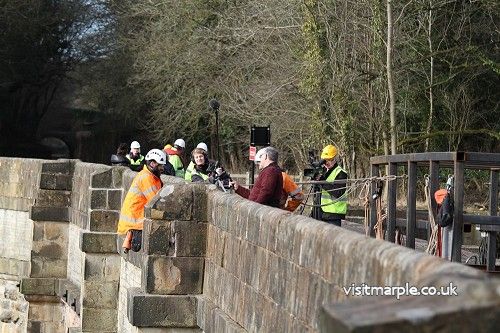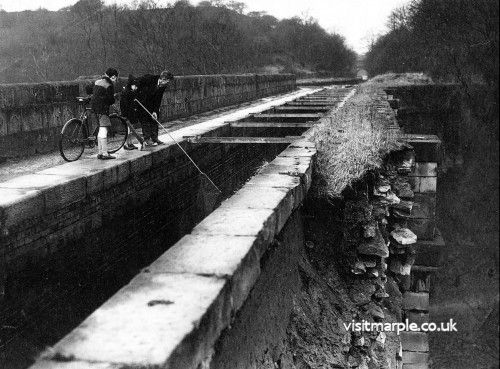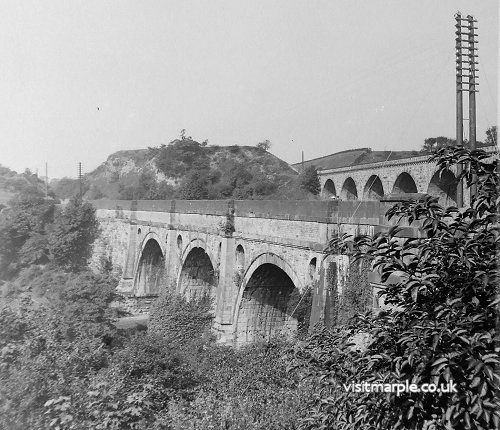 BBC and Granda TV visit Marple Aqueduct 17 February 2015
BBC and Granda TV visit Marple Aqueduct 17 February 2015
This article was written by Mark Whittaker in 2000. The Society would like to thank Mark for his kind permission to 'reprint' his work here.
It is taken from the History & Heritage page on...
http://www.marple-uk.com/heritage
Without fanfare or celebration a major anniversary has quietly been reached in Marple this Millennium year. A milestone that would have most towns hanging out the flags and bunting has barely been acknowledged in the local community. The achievement is all the more significant because it would not have happened without strong public support many years ago, so it is ironic that it appears to be passing almost unnoticed now.
Close to ruin
A little less than 40 years ago the Marple Aqueduct was close to ruin. After gradual decline due to lack of maintenance over many years, water began to seep into the stonework. During the long cold winter of 1961-62 this froze and caused severe damage to the walls of the Aqueduct and a large section fell into the River Goyt below. At this time the canals were already un-navigable due to the sorry condition of the locks and it looked like time might be up for this magnificent structure, once described as "a wonder of the age" by author George Borrow
Costs for a full repair were estimated at £35,000, a huge amount of money in the 60's and for a saving Fishing in Marple Aqueduct after the collapse in 1962, before it was restored. of £8,000 it was possible to pipe the water across the Goyt Valley instead. To make matters worse, during the winter of 62-63, the coldest on record for 200 years, further damage occurred and the costs escalated even higher.
Fishing in Marple Aqueduct after the collapse in 1962, before it was restored. of £8,000 it was possible to pipe the water across the Goyt Valley instead. To make matters worse, during the winter of 62-63, the coldest on record for 200 years, further damage occurred and the costs escalated even higher.
With the previous track record of local authorities for demolishing historic buildings with little thought of our heritage, the aqueduct must have seemed doomed but thanks to volunteer pressure groups and unprecedented foresight, the Council and British Waterways were persuaded to foot the larger bill. It is thanks to this decision that the bicentenary of the completion of the Marple Grand Aqueduct, now a listed structure, has been reached this year.
Construction
The Aqueduct was designed and built by Benjamin Outram, Consultant Engineer for the Peak Forest Canal and the Resident Engineer, Thomas Brown, of Disley. Outram, from Alfreton in Derbyshire, was an outstanding Engineer of his time and was involved in the construction of many canals including the Manchester, Bolton and Bury, the Ashton and the Huddersfield Narrow. Thomas Brown, over thirty years later, was also Resident Engineer on the Macclesfield Canal.
Construction started without ceremony in May 1794 with the laying of the foundation stones. Work also commenced on the upper section of the Peak Forest Canal, from Top Lock to Bugsworth and on the lower section from the Aqueduct to Dukinfield at around the same time. Tools used during the construction were made at the Spade Forge on Longhurst Lane and the stone for the lower half of the piers was obtained from Hyde Bank Quarry, just north of the aqueduct.
The aqueduct took almost seven years to complete, during which seven men lost their lives. The arches were keyed in by 1799 but it was not  until late 1800 that work was completed and the water let in. An interesting comparison can be drawn with the railway viaduct now running alongside. This much larger structure was built around sixty-five years later, by which time construction methods and techniques had advanced so much, it took only a year to build, with no loss of life.
until late 1800 that work was completed and the water let in. An interesting comparison can be drawn with the railway viaduct now running alongside. This much larger structure was built around sixty-five years later, by which time construction methods and techniques had advanced so much, it took only a year to build, with no loss of life.
The Grand Aqueduct, as it became known, measures 309 feet in width and towers 100 feet above the River Goyt at its central point. The whole structure contains 8,000 cubic yards of masonry. The shoulders of the arches are pierced with hollow cylinders to lessen the weight bearing down on the piers, which are oval in section and constructed of rough red sandstone. The upper section is mainly of white hewn and dressed stone, whilst a contrasting coloured grit-stone, used for the parapet and ledges, adds an artistic touch. The water channel was originally brick faced with a clay puddle backing but the major repairs in the 60's replaced this with concrete.
Millennium Plaque
Despite the quiet passing of this 200 year milestone the future of the aqueduct should remain secure, thanks to its grade I listed status. In addition, it was chosen by Stockport residents as one of twelve people or features that have shaped the borough's heritage. It was due to be commemorated with the erection of a blue Millennium plaque in the year 2000, however, for reasons that can only be explained by Stockport Council and British Waterways, this was not erected until 2010. Congratulations to Marple Locks Heritage Society for their stamina and perseverance in getting this done!
At the time of writing this piece I said:
"It would be perfect if this celebration could be accompanied by improvements to the steps and public footpath leading down from the aqueduct and passing underneath. By clearing some of the trees which almost completely obscure it from view, the scene could be returned to how it must have appeared to George Borrow when he first declared it "a wonder of the age".
Following the success of Mellor Archaeological Trust and the Canal and River Trust's "Revealing Oldknow's Legacy" Lottery bid in September 2013, this work is now underway.

